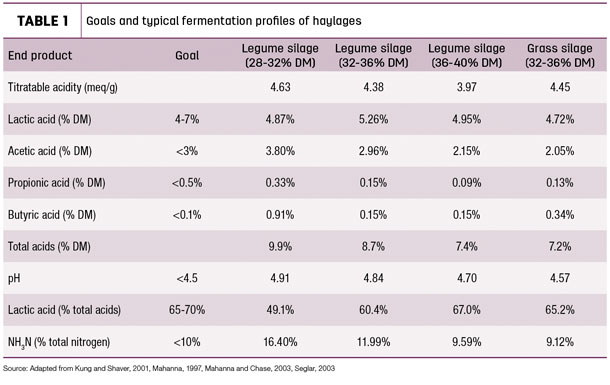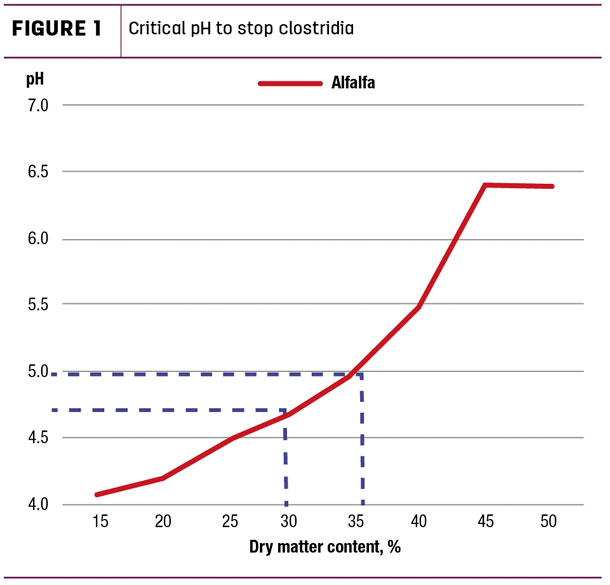Harvesting multiple crops with numerous environmental challenges throughout the summer creates situations dairy producers must manage properly to assure a desired outcome.
Feeding alfalfa silage with high levels of butyric acid has long-term negative effects on dairy cows. Reduced feed intake, production, fertility, increased ketosis and animal health are all impacted. Prevention is always better than a cure, so consideration should be made to prevent harvesting silages high in butyric acid.
So why are alfalfa silages so susceptible to clostridial fermentation? There are numerous challenges; some are controllable and some uncontrollable. Following are some key actions dairy producers can incorporate into the alfalfa management program to ensure a more consistent feed source for their animals.
Action – Harvest at the correct moisture. This is the single-most important action that can be taken to avoid a clostridial fermentation. Harvesting alfalfa above 68 percent moisture increases the chances of a clostridial fermentation significantly (Table 1).

Less dry matter means less fermentation substrate (sugar). Once the substrate is consumed by the lactic-acid-producing bacteria (LABs), fermentation stops. The challenge is compounded by higher moisture content. The additional water needs to be acidified, requiring additional acid production.
Once fermentation has stopped, the pH is no longer declining. Without a low pH to stabilize the environment, the slower-developing clostridia bacteria will begin utilizing the lactic acid as an energy source, essentially converting lactic acid to butyric acid. Therefore, if harvested at the correct moisture, the chances of a clostridial fermentation drops significantly.
Target dry matter for alfalfa silage should be 35 to 42 percent (58 to 65 percent moisture) to minimize the chances of a clostridial fermentation.
Figure 1 shows the critical pH to prevent the growth of clostridia in alfalfa silage. Clostridia tends to be controlled when harvested and ensiled at dry matters of 35 percent and greater without a significant amount of butyric acid production.

The graph shows when alfalfa is wilted down to 35 percent dry matter (or greater), a critical pH of 5.0 is achieved to prevent clostridial growth. In higher moisture conditions, the pH to prevent clostridia is significantly lower. The problem continues to compound as clostridia break down protein-producing ammonia, which raises the pH, allowing continued clostridial growth.
Action – Control soil contamination. Reducing excessive soil and manure in alfalfa silage is critical to preventing clostridial growth. Ash is a measurement of plant mineral content. Minerals in feeds can be broken down into two general categories: endogenous and exogenous. Endogenous minerals can be loosely defined as minerals plants normally contain, such as calcium, phosphorus, potassium and magnesium, etc. Typically, endogenous minerals will represent 6 to 8 percent of the ash content in alfalfa.
Any ash content higher than that should be considered exogenous minerals. Exogenous minerals are primarily the minerals associated with soil. High soil (exogenous mineral) content poses several challenges. First, it is a source of undesirable microorganisms. Clostridia species that produce butyric acid (butyricum, tyrobutyricum and sporogenes) live in the soil. These organisms are undesirable in silage because they compete with beneficial LABs for nutrients before and during fermentation. Second, ash itself is a buffer, requiring more lactic acid to drop pH to a desired level.
Harvesting practices that pick up or agitate soil are typically the cause of high soil contamination in alfalfa silage.
Action – Inoculate silage with a high-quality, lactic-acid-producing bacteria product to influence and direct fermentation to a desired outcome. Silage additives play a significant role in limiting clostridia in alfalfa silage crops. Producers should always apply a good LAB inoculant that supplies a minimum of 150,000 colony-forming units (CFUs) of LABs per gram of ensiled material. The inoculant should also contain enzymes to help increase sugar content for fermentation. The practice of applying a high-quality LAB inoculant will not prevent a clostridial fermentation, but research has proven to reduce negative production of butyric acid significantly.
Action – Segregate any silage that may be at risk of potential clostridial fermentation if forced to harvest in suboptimal conditions. This is especially important when it is stored in a bunker or drive-over pile. The challenge with bunkers and piles is these storage units are filled horizontally and fed vertically. Once you “layer” in bad feed, you tend to destroy the good feed below and above the bad layer. Remember, a clostridial fermentation takes time to develop. Typically, the butyric acid levels will not peak until 21 to 28 days after ensiling. An action opportunity would be to start feeding at-risk feed five to seven days post-ensiling, when lactic acid is at its peak and before clostridia has had the opportunity to convert lactic acid to butyric acid. The idea is to have as much of the feed fed before it turns into a high-butyric-acid silage train wreck.
Action – Fill, pack and cover alfalfa silage as fast as possible. These steps will help prevent prolonged plant respiration from depleting necessary sugars to fuel an adequate fermentation. This is critical to ensure an oxygen-free environment is maintained. Oxygen is the enemy.
Preventing a clostridial fermentation will always be a challenge for dairy producers. However, if producers are committed to incorporating these key actions, it can be managed effectively. ![]()

-
Troy Brown
- Forage Product Manager
- Form-A-Feed Inc.
- Email Troy Brown










